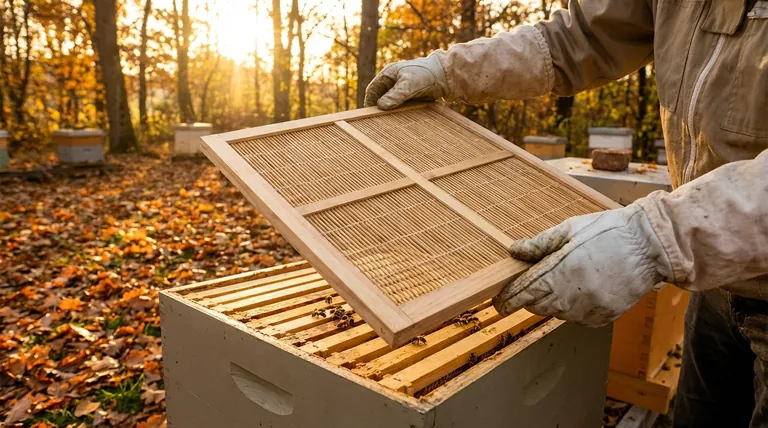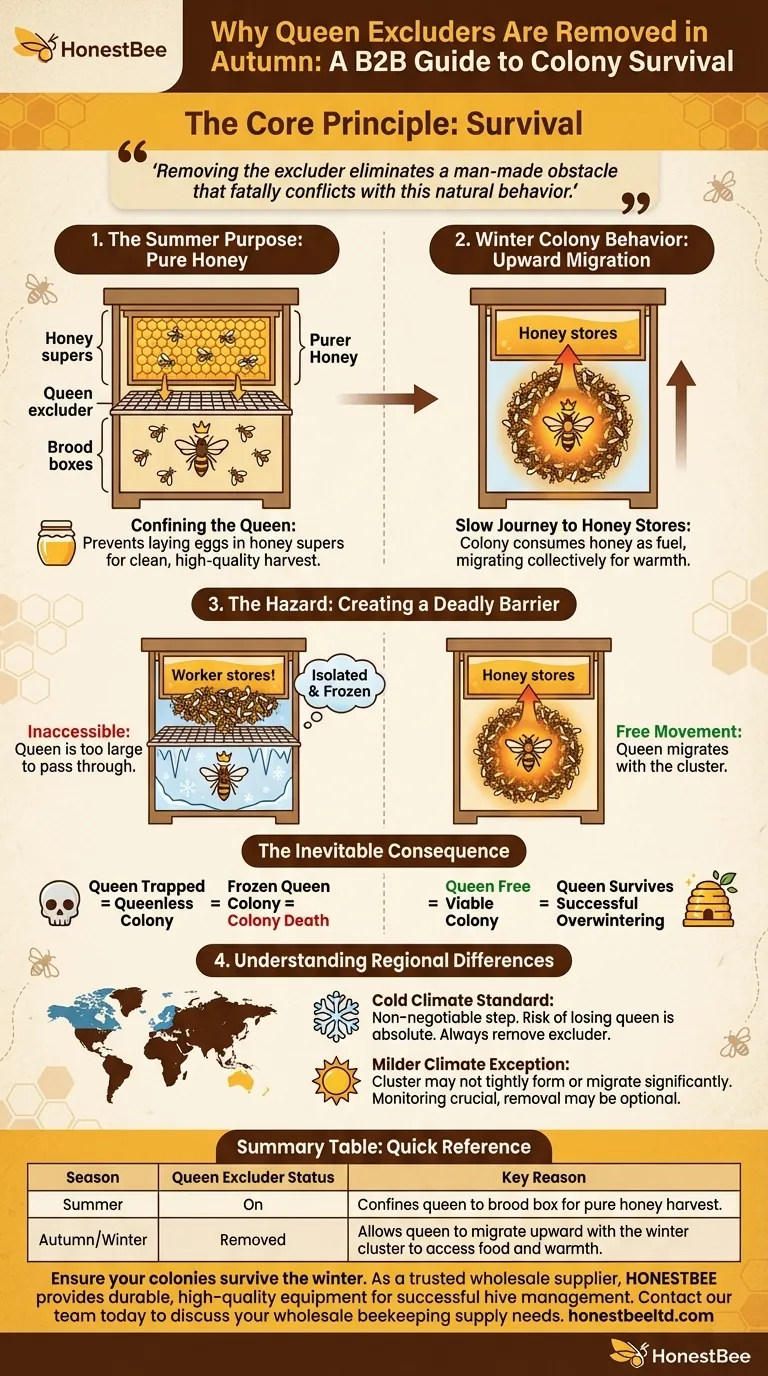In short, queen excluders are removed in the autumn to save the queen's life. During winter, the honeybee colony forms a tight cluster that slowly migrates upward through the hive to access honey stores and maintain warmth. If a queen excluder is left in place, it becomes a fatal barrier, trapping the queen below while the cluster moves up, causing her to freeze to death and dooming the colony.
The core principle is one of survival. A hive's winter strategy depends on the entire colony, including the queen, functioning as a single, mobile unit. Removing the excluder eliminates a man-made obstacle that fatally conflicts with this natural behavior.

The Excluder's Purpose: A Tool for Summer
Confining the Queen for Purer Honey
A queen excluder is a grid placed between the brood boxes and the honey supers. The slots are large enough for worker bees to pass through but too small for the larger queen.
Its primary function is to prevent the queen from laying eggs in the honey supers, the frames designated for honey storage and eventual harvest.
Maintaining Honey Quality
This separation is crucial for producing the cleanest, highest-quality honey. When queens lay eggs in honey frames, the resulting brood cells leave behind debris, shed cocoons, and bee feces.
This not only makes honey extraction more difficult but can also result in a darker, less pure product, which is less desirable for consumption.
Winter Colony Behavior: The Upward Migration
Forming the Winter Cluster
As temperatures drop in the autumn, honeybees stop foraging and form a tight cluster inside the hive to conserve heat. They generate warmth by vibrating their wing muscles.
The queen is always kept in the warmest, most central part of this cluster, protected by thousands of her workers.
The Slow Journey to Honey Stores
The winter cluster is not static. It functions as a living engine that consumes honey as fuel to generate heat.
As the bees consume the honey stores directly around them, the entire cluster must slowly and collectively move upward through the hive to reach the next patch of honey. This upward migration is essential for survival through a long winter.
Why the Excluder Becomes a Hazard
Creating a Deadly Barrier
The queen excluder, so useful in summer, becomes a deadly hazard in winter. As the cluster migrates upward into the honey stores, the worker bees can easily pass through the grid.
The queen, however, is too large. She is physically blocked from moving with her colony.
The Inevitable Consequence: A Frozen Queen
The cluster will not abandon its upward path toward life-sustaining food. It will move above the excluder, leaving the queen behind in the now-empty and cold lower part of the hive.
Isolated from the cluster's warmth, she will quickly freeze and die.
The Fate of a Queenless Winter Colony
A colony that loses its queen in the winter cannot survive. The bees are unable to raise a new queen without fresh eggs, and introducing a replacement queen is nearly impossible.
The bees will not readily accept a new queen's pheromones in the dead of winter, often leading them to kill her. A queenless winter colony is a dead colony.
Understanding the Trade-offs and Regional Differences
The Cold Climate Standard
In regions with long, cold winters, such as the Northern Hemisphere, removing the queen excluder is a non-negotiable step in winter preparation. The risk of losing the queen is absolute.
The minimal benefit of keeping the brood box perfectly defined is insignificant compared to the certainty of colony death if the excluder is left in place.
The Milder Climate Exception
This practice is not universal and depends entirely on your local climate. In regions with very mild winters, like parts of Australia, honeybee colonies may not form a tight, migratory winter cluster.
In these areas, brood rearing may continue year-round, albeit at a reduced rate. If the cluster does not need to make a significant upward migration, the excluder poses less of a threat, and some beekeepers may choose to leave it on.
Making the Right Decision for Your Hive
Your decision must be guided by the realities of your local climate and the predictable behavior of your bees.
- If your primary focus is surviving a cold winter: Always remove your queen excluder in the autumn to guarantee the queen can move with the winter cluster.
- If your primary focus is managing a hive in a mild, subtropical climate: You may be able to leave the excluder in place, but you must monitor the colony to ensure the cluster is not separating from the queen.
Ultimately, successful overwintering depends on enabling the colony's natural survival strategies, not hindering them.
Summary Table:
| Season | Queen Excluder Status | Key Reason |
|---|---|---|
| Summer | On | Confines queen to brood box for pure honey harvest. |
| Autumn/Winter | Removed | Allows queen to migrate upward with the winter cluster to access food and warmth. |
Ensure your colonies survive the winter. As a trusted wholesale supplier to commercial apiaries and distributors, HONESTBEE provides the durable, high-quality equipment you need for successful hive management year-round. Let our expertise support your operation. Contact our team today to discuss your wholesale beekeeping supply needs.
Visual Guide

Related Products
- Wooden Queen Bee Excluder for Beekeeping
- Professional Plastic Queen Excluder for Modern Beekeeping
- High Performance Plastic Queen Excluder for Beekeeping and Apiary Management
- Premium Wood Framed Metal Wire Queen Bee Excluder
- Plastic Queen Bee Excluder for Bee Hive Wholesale
People Also Ask
- What are the advantages of using a queen excluder? Boost Honey Harvest Efficiency & Hive Control
- What are the advantages of using excluders in terms of wax recovery? Maximize Your Yield of Premium Beeswax
- What makes polyurethane foam environmentally friendly? The Surprising Benefits of a Durable, Inert Material
- Can a virgin queen bee get through a queen excluder? Uncover the Critical Swarm Risk
- Which is better, plastic or metal queen excluder? A Guide to Long-Term Hive Success



















